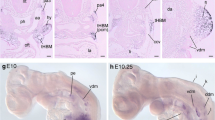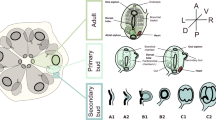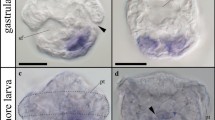Abstract
The formation of the body wall musculature in vertebrates is assumed to be initiated by direct ventral extension of the somites/myotomes. This contrasts to the formation of limb muscles and muscles involved in feeding or respiration/ventilation, which are founded by migratory muscle precursors (MMPs) distant to the somites. Here, we present evidence from morphology and expression of molecular markers proposing that the formation of the two muscle layers of the teleost body wall involves both of the above mechanisms: (1) MMPs from somites 5 and 6 found an independent muscle primordium–the so-called posterior hypaxial muscle (PHM)–which subsequently gives rise to the most anterior two segments of the medial obliquus inferioris (OI) muscle. (2) Direct epithelial extension of the hypaxial myotomes generates the OI segments from somite 7 caudalward and the entire lateral obliquus superioris (OS) muscle. The findings are discussed in relation to the evolution of hypaxial myogenic patterning including functional considerations. We hypothesise that the potential of the most anterior somites to generate migratory muscle precursors is a general vertebrate feature that has been differently utilised in the evolution in vertebrate groups.





Similar content being viewed by others
References
Barresi MJ, D'Angelo JA, Hernández LP, Devoto SH (2001) Distinct mechanisms regulate slow-muscle development. Curr Biol 11:1432–1438
Buckingham M, Vincent SD (2009) Distinct and dynamic myogenic populations in the vertebrate embryo. Curr Opin Genet Dev 19:444–453
Burke AC, Nowicki JL (2003) A new view of patterning domains in the vertebrate mesoderm. Dev Cell 4:159–165
Candia AF, Hu J, Crosby J, Lalley PA, Noden D, Nadeau JH, Wright CV (1992) Mox-1 and Mox-2 define a novel homeobox gene subfamily and are differentially expressed during early mesodermal patterning in mouse embryos. Development 116:1123–1136
Christ B, Jacob M, Jacob HJ (1983) On the origin and development of the ventrolateral abdominal muscles in the avian embryo. An experimental and ultrastructural study. Anat Embryol 166:87–101
Coumailleau P, Duprez D (2009) Sim1 and Sim2 expression during chick and mouse limb development. Int J Dev Biol 53:149–157
Dietrich S, Schubert FR, Healy C, Sharpe PT, Lumsden A (1998) Specification of the hypaxial musculature. Development 125:2235–2249
Durland JL, Sferlazzo M, Logan M, Burke AC (2008) Visualizing the lateral somitic frontier in the Prx1Cre transgenic mouse. J Anat 212:590–602
Evans DJ, Valasek P, Schmidt C, Patel K (2006) Skeletal muscle translocation in vertebrates. Anat Embryol 211:43–50
Gibson-Brown JJ, Agulnik SI, Silver LM, Papaioannou VE (1998) Expression of T-box genes Tbx2-Tbx5 during chick organogenesis. Mech Dev 74:165–169
Gross MK, Moran-Rivard L, Velasquez T, Nakatsu MN, Jagla K, Goulding M (2000) Lbx1 is required for muscle precursor migration along a lateral pathway into the limb. Development 127:413–424
Haines L, Currie PD (2001) Morphogenesis and evolution of vertebrate appendicular muscle. J Anat 199:205–209
Haines L, Neyt C, Gautier P, Keenan DG, Bryson-Richardson RJ, Hollway GE, Cole NJ, Currie PD (2004) Met and Hgf signaling controls hypaxial muscle and lateral line development in the zebrafish. Development 131:4857–4869
Hernández LP, Barresi MJF, Devoto SH (2002) Functional morphology and developmental biology of zebrafish: reciprocal illumination from an unlikely couple. Integr Comp Biol 42:222–231
Hernández LP, Patterson SE, Devoto SH (2005) The development of muscle fibre type identity in zebrafish cranial muscles. Anat Embryol 209:323–334
Hollway GE, Bryson-Richardson RJ, Berger S, Cole NJ, Hall TE, Currie PD (2007) Whole-somite rotation generates muscle progenitor cell compartments in the developing zebrafish embryo. Dev Cell 12:207–219
Huang R, Zhi Q, Izpisua-Belmonte JC, Christ B, Patel K (1999) Origin and development of the avian tongue muscles. Anat Embryol 200:137–152
Johanson Z (2010) Evolution of paired fins and the lateral somitic frontier. J Exp Zool 314B:347–352
Kusakabe R, Kuratani S (2005) Evolution and developmental patterning of the vertebrate skeletal muscles: perspectives from the lamprey. Dev Dyn 234:824–834
Martin BL, Harland RM (2006) A novel role for lbx1 in Xenopus hypaxial myogenesis. Development 133:195–208
Martin BL, Peyrot SM, Harland RM (2007) Hedgehog signaling regulates the amount of hypaxial muscle development during Xenopus myogenesis. Dev Biol 304:722–734
Neyt C, Jagla K, Thisse C, Thisse B, Haines L, Currie PD (2000) Evolutionary origins of vertebrate appendicular muscle. Nature 408:82–86
Nowicki JL, Takimoto R, Burke AC (2003) The lateral somatic frontier: dorso-ventral aspects of anterio-posterior regionalization in avian embryos. Mech Dev 120:227–240
Ruvinsky I, Oates AC, Silver LM, Ho RK (2000) The evolution of paired appendages in vertebrates: T-box genes in the zebrafish. Dev Genes Evol 210:82–91
Schilling TF, Kimmel CB (1997) Musculoskeletal patterning in the pharyngeal segments of the zebrafish embryo. Development 125(15):2945–2960
Steinbacher P, Haslett JR, Six M, Gollmann HP, Sänger AM, Stoiber W (2006) Phases of myogenic cell activation and possible role of dermomyotome cells in teleost muscle formation. Dev Dyn 235:3132–3143
Stellabotte F, Dobbs-McAuliffe B, Fernandez DA, Feng X, Devoto SH (2007) Dynamic somite cell rearrangements lead to distinct waves of myotome growth. Development 134:1253–1257
Vasyutina E, Birchmeier C (2006) The development of migrating muscle precursor cells. Anat Embryol 211:37–41
Winterbottom R (1974) A descriptive synonymy of the striated muscles of the Teleostei. Proc Acad Natl Sci 125:225–317
Acknowledgements
We are grateful to Stephen H. Devoto for most valuable discussions on the manuscript, and Synnöve Tholo and Stefanie Geisler for excellent technical support. We thank Hans-Peter Gollmann and Alois Neuhofer at the Institute of Freshwater Ecology, Fisheries Management and Lake Research, Scharfling, Austria, for rearing the fish.
Grant sponsor
Austrian Science Foundation (FWF), Grant number P20430.
Author information
Authors and Affiliations
Corresponding author
Additional information
Communicated by T. Hollemann
Stefanie Windner and Peter Steinbacher contributed equally to this study.
Rights and permissions
About this article
Cite this article
Windner, S.E., Steinbacher, P., Obermayer, A. et al. Distinct modes of vertebrate hypaxial muscle formation contribute to the teleost body wall musculature. Dev Genes Evol 221, 167–178 (2011). https://doi.org/10.1007/s00427-011-0369-1
Received:
Accepted:
Published:
Issue Date:
DOI: https://doi.org/10.1007/s00427-011-0369-1




